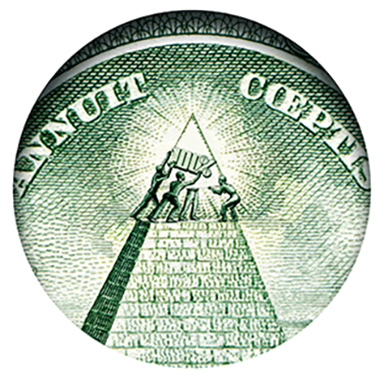| October 31, 2022 |
| Offshore Investment Guide |

Dear ,
Could gold be the basis for a new global currency?
Every international reserve currency in history started out backed by gold. Whether it was the pound, the dollar, the florin or the currencies of the ancient world, they were all at least as good as gold, if not gold itself. Gold has always been the most reliable form of money.
Now collaboration between China and Russia could lead to a new gold-backed currency. Hold on to your hats, the race is on.
|
| Ground-breaking SWIFT innovation paves way for global use of CBDCs and tokenised assets |

SWIFT has successfully shown that Central Bank Digital Currencies (CBDCs) and tokenised assets can move seamlessly on existing financial infrastructure – a major milestone towards enabling their smooth integration into the international financial ecosystem.
The findings, from two separate experiments, solve the significant challenge of interoperability in cross-border transactions by bridging between different distributed ledger technology (DLT) networks and existing payment systems, allowing digital currencies and assets to flow smoothly alongside, and interact with, their traditional counterparts. This important step forward builds on SWIFT’s core capabilities and means that as CBDCs and tokens develop, they can be rapidly deployed
at scale to facilitate trade and investment between more than 200 countries and territories around the world. Interlinking CBDCs for seamless cross-border payments
Globally, nine out of 10 central banks are actively exploring digital currencies — often using different technologies and with a primary focus on domestic use. For the potential of CBDCs to be fully realised across borders, these digital currencies need to overcome inherent differences to interact with each other, as well as with traditional fiat currencies.
SWIFT, in collaboration with Capgemini, achieved CBDC-to-CBDC transactions between different DLT networks based on popular Quorum and Corda technologies, as well as fiat-to-CBDC flows between these networks and a real-time gross settlement system. The success showed that the blockchain networks could be interlinked for cross-border payments through a single gateway, and that SWIFT’s new transaction management capabilities could orchestrate all inter-network communication. 14
central and commercial banks, including Banque de France, the Deutsche Bundesbank, HSBC, Intesa Sanpaolo, NatWest, SMBC, Standard Chartered, UBS and Wells Fargo, are now collaborating in a testing environment to accelerate the path to full scale deployment.
Unlocking the potential of tokenised assets
In a separate experiment with a different group of participants, SWIFT similarly demonstrated that its infrastructure can serve as an interconnector between multiple tokenisation platforms and different types of cash payment.
Working in collaboration with Citi, Clearstream, Northern Trust, and SETL, its technology partner, SWIFT explored 70 scenarios simulating market issuance and secondary market transfers of tokenised bonds, equities and cash. It successfully served as a single access point to various tokenised networks and showed its infrastructure could be used to create, transfer and redeem tokens and update balances between multiple client wallets, as well as provide interoperability between
different tokenisation platforms and existing account-based infrastructure.
Tokenisation is a relatively nascent market, but the World Economic Forum has estimated it could reach $24tn by 2027. The potential benefits include greater market liquidity and fractionalisation, which could increase access to investment markets for retail investors, and enable institutional investors to build stronger portfolios.
Tom Zschach, Chief Innovation Officer at SWIFT, said: “Digital currencies and tokens have huge potential to shape the way we will all pay and invest in the future. But that potential can only be unleashed if the different approaches that are being explored have the ability to connect and work together. We see inclusivity and interoperability as central pillars of the financial ecosystem, and our innovation is a major step towards unlocking the potential of the digital future. For
CBDCs, our solution will enable central banks to connect their own networks simply and directly to all the other payments systems in the world through a single gateway, ensuring the instant and smooth flow of cross-border payments.
“Tokenisation has great potential when it comes to strengthening liquidity in markets and increasing access to investment opportunities, and SWIFT’s existing infrastructure can ensure these benefits can be realised at the earliest opportunity, by as many people as possible.”
The experiments are part of SWIFT’s extensive innovation agenda in support of its strategic focus on enabling instant, frictionless and interoperable cross-border transactions. The cooperative, which connects more than 11,500 financial institutions and 4 billion accounts across 200 countries and territories, was created to bridge geographies, technologies and currencies. And it has been transforming the underlying infrastructure of the global economy at pace to meet the rapidly
changing requirements of businesses and consumers. This includes a new standard, SWIFT Go, for low value payments, and services like Payment Pre-validation that uses predictive intelligence to pre-check international payments before they begin to prevent common mistakes that cause delays.
Full details of the experiments, and the results, can be found here:
|
| Russia, China Preparing for a New Gold Standard on BRICS |

Great Britain became the first country to adopt the gold standard—albeit accidentally—in 1717. Sir Isaac Newton, who was the Master of the Royal Mint at the time, mistakenly set the exchange rate for silver to gold too low. This resulted in such a run on gold that all the silver coins in the country were traded in for gold.
The U.K. officially adopted the classical gold standard in 1821, only to leave in 1914. Britain later joined the Interwar Gold Standard in 1925 but stopped using the Gold Standard for the final time in 1931.
The Gold Standard in the United States
Despite the fact that the United States currently holds the world’s largest gold reserves, the country officially moved on from the gold standard in 1933. However, the US also returned to the concept by adopting the Bretton Woods Agreement in 1944. Bretton Woods was designed as an international-only gold standard, in which the United States dollar became the dominant reserve currency and currencies from other nations were pegged to its value, but still backed by U.S. gold. Over
time, however, the agreement led to too much U.S. gold being transferred out of the country. The U.S. suspended the Bretton Woods Agreement in 1971, and changed the definition of the dollar—officially removing the last remnants of the gold standard—in 1976.
The Gold Standard in Germany
Germany first adopted the gold standard in 1871, a move largely attributed to the development of the International Gold Standard. Germany's change is credited with influencing several other countries to also adopt the gold standard, including Russia, Austria-Hungary, Italy, and the Netherlands.
Germany went off the gold standard in 1914, due in large part to the fact that war reparations had depleted the country's gold reserves. Germany returned to a gold-based system (or the phantom of one) in 1923 (as did Austria in 1923, Poland in 1924, and Hungary in 1925) to combat post-WWI hyperinflation, but ultimately abandoned it for good.
The Gold Standard in France
When it comes to the gold standard, France is famous for having led the "gold bloc." In 1931, during the Great Depression, many countries, including Great Britain, Denmark, Norway, Sweden, Finland, and Japan, chose to abandon the gold standard. However, France and the other members of the gold bloc—Belgium, Italy, Luxembourg, the Netherlands, Poland, and Switzerland—were determined to remain on the gold standard. Ultimately, the goal proved untenable. Belgium and Luxembourg gave up
the gold standard in 1935, and France and the remaing gold bloc countries abandoned it with the signing of the Tripartite Agreement in September 1936.
The Gold Standard in Switzerland
Switzerland is one of the top countries with the largest gold reserves, and was also the last country to eliminate its connection to the gold standard. In 1999, the country voted to sever ties between the country’s currency and gold, meaning the Swiss franc need not be backed by gold.
In 2014, Switzerland seemed poised to return to the gold standard under the “Save our Swiss Gold” motion. This initiative stipulated that the Swiss National Bank’s assets should include at least 20% gold, and the SNB should be banned from selling gold or storing its gold reserves abroad. However, the initiative was rejected by voters and ultimately failed.
The Gold Standard for BRICS
Russia, China may be preparing new gold-backed currency, but expert assures US dollar 'safest' currency today. However,
China in July purchased 80.1 tons of gold valued at $4.6 billion
China and Russia may be working toward a new gold-backed currency in a move that would aim to dethrone the dollar as the primary reserve currency of the world, but any such currency would unlikely achieve that goal.
"The USD remains the safest, most convenient and most widely used currency in Asia and in the world today," according to Min-Hua Chiang, a research fellow and economist at the Heritage Foundation’s Asian Studies Center. "No other currency (backed by gold or otherwise) is comparable, and that is unlikely to change in the near future."
|
| Spooky Science: Quantum Computing, the Fed, and the Future |

by Patrick T. Harker President and Chief Executive Officer, Federal Reserve Bank of Philadelphia
Another great technological leap is on the horizon as quantum computing presents a way to turbocharge our computing power. As the nation's central Bank, we’re at the forefront of exploring how this innovation, with its benefits and risks, can strengthen our nation's financial infrastructure.
Ever since I was a little boy taking apart transistor radios to see the magic inside, I’ve been fascinated with the way things work. Or as my family and friends have sometimes more bluntly put it, I’ve always been a tech geek. Now, as president of a Reserve Bank and chair of a Federal Reserve committee focused on technology, I put my interest in the subject to work each day.
Luckily for me and my fellow techies, ours is an age of remarkable innovation. From the development of personal computers, smartphones, and the Internet to the rise of gene therapies, stem cell treatments, and carbon-zero electricity, technological development has a played a part in making the world more healthy, green, convenient, and — as we all know — at times distracting.
We now stand at the precipice of another great technological leap: the development and deployment of quantum computing, a potentially revolutionary technology. This is an exciting time, full of opportunity but also fraught with no small amount of risk. The Federal Reserve, as the nation’s central bank and a regulator, has a strong interest in fostering an environment that is conducive to innovation and that safeguards our country’s financial infrastructure.
So, what is quantum computing? To begin to answer that question, it helps to think a little bit about quantum mechanics.
Quantum mechanics is a branch of theoretical physics that is, fundamentally, the study of very, very small things — specifically, the behavior of matter and light at subatomic scales. These tiniest discrete units are called quantum particles.
Once you get to such a tiny scale, things behave strangely. They don’t act at all like the objects we see in our day-to-day lives.
Quantum particles can, for instance, be in a state of superposition, which is not easy to get your head around. During superposition, quantum particles are simultaneously in a combination of all of their possible states. Imagine a quarter that shows both heads, tails, and every state in between, at the same time, which would definitely complicate an NFL coin toss.
And then, there’s quantum entanglement. What is it? I like this description from Cal Tech: “When two particles, such as a pair of photons or electrons, become entangled, they remain connected even when separated by vast distances. In the same way that a ballet or tango emerges from individual dancers, entanglement arises from the connection between particles.”
No wonder Albert Einstein once described quantum entanglement as “spooky action at a distance.” Or, if you prefer a more scientific term than “spooky,” you could also say “weird.”
What’s so exciting is that quantum computing is making what was formerly theoretical, real.
Here’s how: Quantum computing builds on the insights found in quantum mechanics to vastly expand computing power. Instead of just zeros and ones, quantum computers employ quantum principles like superposition and entanglement. Instead of “bits” — zeros and ones — quantum computers use what are called qubits. That is, they compute using zeros, ones, and everything in between — simultaneously. This makes them extraordinarily powerful when it comes to performing tasks like machine
learning, search, and cryptography. These are the true supercomputers of a rapidly approaching future.
Here, I think, the opportunities and risks for governments, businesses, institutions, and even individuals are clear. Whether you call it spooky, weird, or just plain exciting, there can be no doubt that quantum computing has the potential to revolutionize our world.
Imagine, for instance, quantum computers simulating the structure, properties, and behavior of molecular structures, the building blocks of pharmaceuticals. The benefits for drug development could be profound.
Or imagine financial institutions using quantum computing to more accurately calculate risk, allowing them to promote inclusion while simultaneously strengthening their balance sheets and reducing threats to the financial system.
Closer to home, deploying quantum technologies to run economic models could greatly strengthen our understanding of the economy and the way it reacts to shifts in the Fed’s monetary policy.
All in all, it’s little wonder that some of the biggest names in technology, banking, and pharmaceuticals are making heavy investments in quantum technology.
A cause for more worry is the prospect of quantum technologies falling into the wrong hands. One thing is for certain: Current methods of encryption will not stand up to quantum cryptography. Governments, corporations, and institutions are already working hard to develop quantum-safe encryption and that’s a good thing. The cyber environment is already rife with threats from malevolent state actors to online bandits, and quantum technologies will only intensify them. For our part,
making sure the financial system and the Federal Reserve are secure is at the top of our priority list.
You can learn more about quantum computing in this video and take a deeper look at some of the challenges posed by quantum computing in this paper from the Global Risk Institute.
|
|
|





 About us
About us